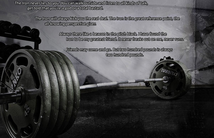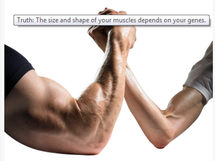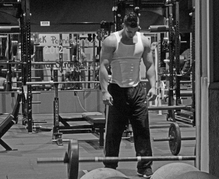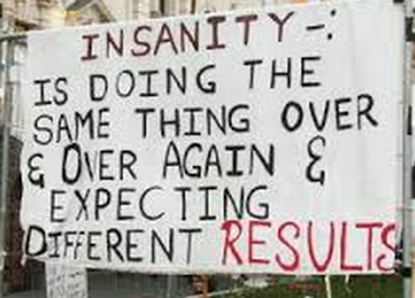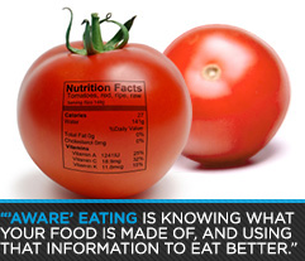YOU’RE EXPECTING NEW RESULTS FROM THE SAME METHOD.
Working in the field of fitness and nutrition isn’t always a picnic with sunshine and lollipops.
When I’m out meeting new people and the discussion of careers comes up, I often like to say I’m employed as a professional pecan farmer.
Using that line is always a great ice breaker and instantly I rival “the most interesting man in the world” as “the most interesting man in the room.”
But the real reason I tend to keep my profession in the health/fitness industry under wraps is because if I tell people what I actually do, they’re instinctively inclined to tell me their life stories about “how I always eat healthy and workout but am not losing weight.”
Or it’s, “I work out all the time and eat like crazy but I’m not gaining muscle.”
From my personal experience, and gauging from the information I’ve collected throughout all of these encounters, I’ve come to this conclusion:
Everybody knows how to eat healthy.
Everybody knows how to work out.
They all say it with such strong conviction. Almost as if it’s been their life work to master the subject in discussion.
But their body compositions and physiques say otherwise.
Maybe these people do know how to eat for their goals- but have yet to commit to it.
Or perhaps they do know how to train to attain the aesthetics of a Greek god.
But again, haven’t applied the knowledge or physically committed to reaching the goals.
Yet these people will claim they’re committed to making real changes, but in reality they’re about as committed as a kamikaze pilot on his 38th mission!
They’ve probably made some sort of progress to their body compositions and health over their lives, but it wasn’t the kind of progress they could continue to maintain; and before they know it they’re frustrated and back to square 1.
And then there are the ones on the opposite end of the spectrum who go to the extreme with their fitness.
They will actually spend more time in the gym working out per week than at their desk jobs. (I wish this was an exaggeration, but it’s not)
And these folks still see very little, if any changes in their physiques.
Fitness is a funny thing. The return on the investment is very short lived and just like everything else in the natural world, the diminishing returns phenomena creeps in relatively quickly.
This is known as hitting a plateau. It happens to everyone sooner than they could ever hope.
The old saying goes, “the few things in life that are inevitable are death and taxes.”
I’d like to add “hitting a fitness plateau” to that short list too.
Few things in this life are as frustrating as putting in endless hours in the gym and giving your literal sweat, blood, and tears to improve your most valuable possession in this world and then not seeing any changes.
So here’s a few tips on what you can do to break through those plateaus and get progress rolling again.
When I’m out meeting new people and the discussion of careers comes up, I often like to say I’m employed as a professional pecan farmer.
Using that line is always a great ice breaker and instantly I rival “the most interesting man in the world” as “the most interesting man in the room.”
But the real reason I tend to keep my profession in the health/fitness industry under wraps is because if I tell people what I actually do, they’re instinctively inclined to tell me their life stories about “how I always eat healthy and workout but am not losing weight.”
Or it’s, “I work out all the time and eat like crazy but I’m not gaining muscle.”
From my personal experience, and gauging from the information I’ve collected throughout all of these encounters, I’ve come to this conclusion:
Everybody knows how to eat healthy.
Everybody knows how to work out.
They all say it with such strong conviction. Almost as if it’s been their life work to master the subject in discussion.
But their body compositions and physiques say otherwise.
Maybe these people do know how to eat for their goals- but have yet to commit to it.
Or perhaps they do know how to train to attain the aesthetics of a Greek god.
But again, haven’t applied the knowledge or physically committed to reaching the goals.
Yet these people will claim they’re committed to making real changes, but in reality they’re about as committed as a kamikaze pilot on his 38th mission!
They’ve probably made some sort of progress to their body compositions and health over their lives, but it wasn’t the kind of progress they could continue to maintain; and before they know it they’re frustrated and back to square 1.
And then there are the ones on the opposite end of the spectrum who go to the extreme with their fitness.
They will actually spend more time in the gym working out per week than at their desk jobs. (I wish this was an exaggeration, but it’s not)
And these folks still see very little, if any changes in their physiques.
Fitness is a funny thing. The return on the investment is very short lived and just like everything else in the natural world, the diminishing returns phenomena creeps in relatively quickly.
This is known as hitting a plateau. It happens to everyone sooner than they could ever hope.
The old saying goes, “the few things in life that are inevitable are death and taxes.”
I’d like to add “hitting a fitness plateau” to that short list too.
Few things in this life are as frustrating as putting in endless hours in the gym and giving your literal sweat, blood, and tears to improve your most valuable possession in this world and then not seeing any changes.
So here’s a few tips on what you can do to break through those plateaus and get progress rolling again.
YOU’RE EXPECTING NEW RESULTS FROM THE SAME OLD METHOD
To borrow a favorite quote of mine used in Alcoholics Anonymous, “The term INSANITY can be used to describe doing the same thing repeatedly and expecting a different result each time.”
To borrow a favorite quote of mine used in Alcoholics Anonymous, “The term INSANITY can be used to describe doing the same thing repeatedly and expecting a different result each time.”
I see this all the time.
Everywhere.
I’ve walked into gyms and seen a couple of guys doing dumbbell curls in front of the mirror.
8 months went by and I returned to the gym to see the same guys, doing the same curls with the same weights, looking. Exactly. The. Same.
After a while you would think they’d realize their plan to get bigger and stronger has failed them and that they need to make a change.
And not even a huge, drastic, overhauling change. But just at least a small change.
But they don’t. They keep plowing away day after day hoping all the hard work will finally kick in and pay off.
But it doesn’t work that way.
I’m not saying it’s not important to commit to a program, but once the program has run its course and you’re not seeing the results you should, that’s your cue to move on and try something else.
Everywhere.
I’ve walked into gyms and seen a couple of guys doing dumbbell curls in front of the mirror.
8 months went by and I returned to the gym to see the same guys, doing the same curls with the same weights, looking. Exactly. The. Same.
After a while you would think they’d realize their plan to get bigger and stronger has failed them and that they need to make a change.
And not even a huge, drastic, overhauling change. But just at least a small change.
But they don’t. They keep plowing away day after day hoping all the hard work will finally kick in and pay off.
But it doesn’t work that way.
I’m not saying it’s not important to commit to a program, but once the program has run its course and you’re not seeing the results you should, that’s your cue to move on and try something else.
Change Your Program When Necessary
Before you can change your program, it’s most important that you have a program to follow.
A lot of people haphazardly workout and exercise just for the sake of exercise.
This isn’t wrong by any means, but just know if this is the route you take your progress will stall out extremely quickly and you’ll be left frustrated about why you lost 5 pounds the first work and nothing more the subsequent 12 weeks.
If you don’t know what to do or where to find decent programming, use your resources.
Like…the internet.
Do some research on your own about workouts and programs that are suited for your specific goals and STICK TO THAT PROGRAM.
Folks tend to find a trendy workout they see in a magazine and run it for a week before they get bored and hop onto another program their friend told them about.
This is a quick way to set you off on a journey that has no final destination.
Once you’ve found a program tailored to your goals and you run the course, then it’s time to assess your accomplishments.
The main question you need to ask yourself is did you get the results you wanted?
If that’s a yes, then by all means continue to use the program.
This is where a lot of trainees will get caught up again.
They’ll run the program again and not make the same progressive increase in weights and/or repetitions in their workouts.
In other words, they’ll become complacent with their workouts and progress with no longer continue.
This is where it takes some intrinsic motivation to really push and remind yourself to continually try and increase the working weights, reps, or sets in a program.
Before you can change your program, it’s most important that you have a program to follow.
A lot of people haphazardly workout and exercise just for the sake of exercise.
This isn’t wrong by any means, but just know if this is the route you take your progress will stall out extremely quickly and you’ll be left frustrated about why you lost 5 pounds the first work and nothing more the subsequent 12 weeks.
If you don’t know what to do or where to find decent programming, use your resources.
Like…the internet.
Do some research on your own about workouts and programs that are suited for your specific goals and STICK TO THAT PROGRAM.
Folks tend to find a trendy workout they see in a magazine and run it for a week before they get bored and hop onto another program their friend told them about.
This is a quick way to set you off on a journey that has no final destination.
Once you’ve found a program tailored to your goals and you run the course, then it’s time to assess your accomplishments.
The main question you need to ask yourself is did you get the results you wanted?
If that’s a yes, then by all means continue to use the program.
This is where a lot of trainees will get caught up again.
They’ll run the program again and not make the same progressive increase in weights and/or repetitions in their workouts.
In other words, they’ll become complacent with their workouts and progress with no longer continue.
This is where it takes some intrinsic motivation to really push and remind yourself to continually try and increase the working weights, reps, or sets in a program.
KEEP A WORKOUT LOG
One method to help make sure you’re continually progressing is using a workout log
I know it may seem cheesy and “newbee-esq” to tote around a pen and notebook with you at the gym, but trust me when I say it is the only way you can physically track your workouts and see your numbers increase.
You don’t have to go all William Shakespeare with the pen and pad while you’re at the gym and write a short story about every last detail about your workout.
In fact, after a while you may not have to have it with you at the gym at all.
As long as you can somehow quantify and track the progression in your main lifts, that’s what really matters most.
At the end of every month, or at the end of a training program block, compare the weights, reps, and sets of a lift from the beginning of the month to the weights, reps, and sets at the end of the month, and see how much you actually progressed in the lift.
If the volume of the lift (reps x sets x weight) hasn’t increased in the slightest, then you can’t expect much in terms of progression.
It’s quite simple. If you want to make progress, you have to progress.
One method to help make sure you’re continually progressing is using a workout log
I know it may seem cheesy and “newbee-esq” to tote around a pen and notebook with you at the gym, but trust me when I say it is the only way you can physically track your workouts and see your numbers increase.
You don’t have to go all William Shakespeare with the pen and pad while you’re at the gym and write a short story about every last detail about your workout.
In fact, after a while you may not have to have it with you at the gym at all.
As long as you can somehow quantify and track the progression in your main lifts, that’s what really matters most.
At the end of every month, or at the end of a training program block, compare the weights, reps, and sets of a lift from the beginning of the month to the weights, reps, and sets at the end of the month, and see how much you actually progressed in the lift.
If the volume of the lift (reps x sets x weight) hasn’t increased in the slightest, then you can’t expect much in terms of progression.
It’s quite simple. If you want to make progress, you have to progress.
COUNT YOUR CALORIES AND TRACK YOUR MACROS
While we’re on the topic of tracking and counting this, let’s address the biggest travesty I see people undergo when attempting to achieve their dream physiques.
They don’t keep track of what they put in their mouths.
I once heard a legendary speaker say, “I was overweight for the first 40 years of my life. Everything I ate that led me to be overweight was my choice.”
Just because you “eat clean” (whatever that means) and avoid fast food and junk food like the plague, that doesn’t guarantee you’re going to pack on muscle mass, shred up, and instantly transform your physique.
While we’re on the topic of tracking and counting this, let’s address the biggest travesty I see people undergo when attempting to achieve their dream physiques.
They don’t keep track of what they put in their mouths.
I once heard a legendary speaker say, “I was overweight for the first 40 years of my life. Everything I ate that led me to be overweight was my choice.”
Just because you “eat clean” (whatever that means) and avoid fast food and junk food like the plague, that doesn’t guarantee you’re going to pack on muscle mass, shred up, and instantly transform your physique.
In my experience, the opposite is entirely possible.
I know folks who have gained body fat following strict paleo diets and low carb diets, just by overconsuming large quantities of food.
Good nutrition isn’t based entirely on what you eat, but how much of what you’re eating.
It’s one of the few things in life that favors quantity over quality.
So the single best thing you can do is learn to count your macro-nutrients (macros).
Counting and tracking macros means knowing the protein, carb, and fat content of the foods you eat and how much you can eat in a given day for fat loss, weight maintenance, and weight gain.
A lot of people are perplexed and downright intimidated by the thought of having to become a full time accountant with their food choices,
But in reality, it’s not that difficult.
In fact, it’s a life skill I believe everybody should attempt to understand. If you can take control of your personal eating habits and change your body for the better, you will undeniably become a better all-around person.
Gaining control of the single most important possession in your life that is your body has countless benefits that can trickle through all parts of your life.
If you can manage to pack on 10 solid pounds of lean muscle (which is no easy feat, folks), what’s stopping you from getting that promotion at work?
Or putting in an extra 2 hours to study for that upcoming exam so you can get the highest mark possible?
I know folks who have gained body fat following strict paleo diets and low carb diets, just by overconsuming large quantities of food.
Good nutrition isn’t based entirely on what you eat, but how much of what you’re eating.
It’s one of the few things in life that favors quantity over quality.
So the single best thing you can do is learn to count your macro-nutrients (macros).
Counting and tracking macros means knowing the protein, carb, and fat content of the foods you eat and how much you can eat in a given day for fat loss, weight maintenance, and weight gain.
A lot of people are perplexed and downright intimidated by the thought of having to become a full time accountant with their food choices,
But in reality, it’s not that difficult.
In fact, it’s a life skill I believe everybody should attempt to understand. If you can take control of your personal eating habits and change your body for the better, you will undeniably become a better all-around person.
Gaining control of the single most important possession in your life that is your body has countless benefits that can trickle through all parts of your life.
If you can manage to pack on 10 solid pounds of lean muscle (which is no easy feat, folks), what’s stopping you from getting that promotion at work?
Or putting in an extra 2 hours to study for that upcoming exam so you can get the highest mark possible?
Don’t be the big fish in a small pond
This method is definitely the simplest, although not the easiest. If you’ve been working out in the same old big box gym over the last 3 years, you’ve probably built yourself a nice little repuatation amongst all the regulars.
You may even be known as the “big” or “jacked” guy.
But if you were to walk into another gym across town, say an old-school gritty, dirty, nothing but heavy iron gym, you’d probably be the smallest and weakest guy in the joint.
In a place like that, you’d come across dumbells ranging over 200 pounds. A far cry from the 130 pound dumbells you’ve seen max out the top of the dumbbell rack at your usual gym.
Like the old adage states, “you never want to be the smartest guy in the room.”
The same applies to lifting and gaining muscle. “You never want to be the biggest guy in the room.”
You should always have an external source of motivation to keep striving for more strength and size, and working out with guys much bigger, stronger, and older than you can definitely be enough motivation for you to give your training a slight edge.
If you feel like your training has stalled out a bit and you’ve become complacent and too comfortable in your usual gym setting, then take a step out of that comfort zone for a bit and immerse yourself in a new environment that can push you to increase your lifts.
Who knows, you may even make some new life-long friends getting out there and working out around folks with the same mentality and goals as you.
Try being the small fish in the ocean for a bit and test your own personal grit and determination. See if you really have what it takes to work your way up the proverbial “food chain” and become a big fish in that big ocean.
Don’t let those inevitable plateaus discourage you all from striving for more.
The longer you train, the more you’ll see plateaus.
But if you arm yourself with some knowledge and perseverance, you’ll overcome those plateaus and continually improve your lifts and body composition throughout your lifting life-spans.
This method is definitely the simplest, although not the easiest. If you’ve been working out in the same old big box gym over the last 3 years, you’ve probably built yourself a nice little repuatation amongst all the regulars.
You may even be known as the “big” or “jacked” guy.
But if you were to walk into another gym across town, say an old-school gritty, dirty, nothing but heavy iron gym, you’d probably be the smallest and weakest guy in the joint.
In a place like that, you’d come across dumbells ranging over 200 pounds. A far cry from the 130 pound dumbells you’ve seen max out the top of the dumbbell rack at your usual gym.
Like the old adage states, “you never want to be the smartest guy in the room.”
The same applies to lifting and gaining muscle. “You never want to be the biggest guy in the room.”
You should always have an external source of motivation to keep striving for more strength and size, and working out with guys much bigger, stronger, and older than you can definitely be enough motivation for you to give your training a slight edge.
If you feel like your training has stalled out a bit and you’ve become complacent and too comfortable in your usual gym setting, then take a step out of that comfort zone for a bit and immerse yourself in a new environment that can push you to increase your lifts.
Who knows, you may even make some new life-long friends getting out there and working out around folks with the same mentality and goals as you.
Try being the small fish in the ocean for a bit and test your own personal grit and determination. See if you really have what it takes to work your way up the proverbial “food chain” and become a big fish in that big ocean.
Don’t let those inevitable plateaus discourage you all from striving for more.
The longer you train, the more you’ll see plateaus.
But if you arm yourself with some knowledge and perseverance, you’ll overcome those plateaus and continually improve your lifts and body composition throughout your lifting life-spans.
Related Articles
